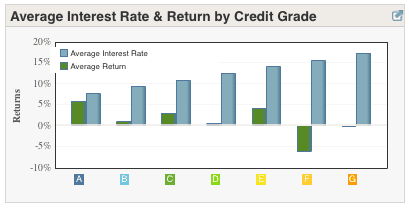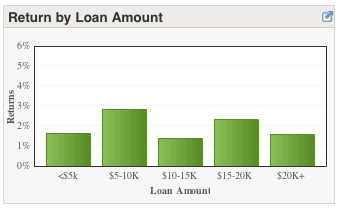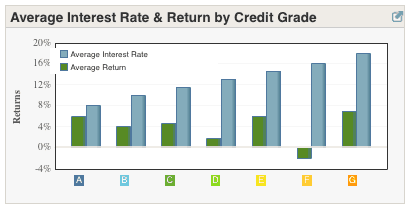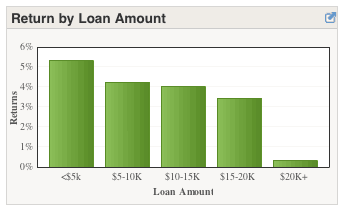I’ve been investing with LendingClub for over two years now. They securitize person-to-person loans so that you can lend money to other people in $25 increments, and you collect the interest after some fees. The stated interest rates are about 7-16%. On their home page, they boast of very impressive returns:
If you had invested $10,000 in Lending Club Notes in June 2007 (when we started issuing loans) and continued to reinvest your returns, you’d have made over 9.5% net annualized returns to date, outpacing a high yield corporate bond index, the NASDAQ, S&P 500 and even 1-3 year treasuries.
While I can only assume this statement is technically true, you have to remember that the way they state the numbers includes a lot of new loans that have not had a chance to “age” until maturity. LendingClub notes are all for a three year term. It would be more informative, in my opinion, to specifically look at the return of only loans that have completed. Since LC is so new, how about as old as possible.
For that, I go to the Statistics section. I should point out that the date range is for the origination date of the loans. The observation date is today. Accordingly, the default view of “Show All Time” shows every single loan from mid-2007 until today. Again, this includes a lot of new loans, many of which are impossible be classified as defaulted yet (must be 120+ days late). Instead, let’s narrow down the origination dates so we can look at loans of a set age.
June 1, 2007 to December 31, 2007
We’ll start with the loans that originated in 2007, their first year of operation. Even though these loans aren’t all completely done, they are the oldest loans available with an average age of about 2.5 years. Here are the average returns and average interest rates, sorted by credit grade:

Here are the average returns by loan amount:

The interest rates being charged (blue) are predetermined by LC, and as you’d expect they increase as credit quality decreases. However, the returns (green) are not what you might expect. Grade A loans appear to have performed the best, but other than that there is no real direct relationship between return and credit grade. I see no clear relationship between loan size and return, either. Most importantly, by visual estimate, the average return for all of these loans is only approximately 2%. This is way off from 9% returns.
(Read on for more…)
January 1st, 2008 to May 31st, 2008
Now, let’s take a look at all the loans that originated in the first half of 2008. This means that they’re about 2 years old now, give or take a few months.


By visual estimate, the average return for these loans is only approximately 4%. This is still much lower than I would have liked to see, and it indicates that return does continue to drop with age.
Again, there is no apparent relationship between return and credit grade. The returns ranged from negative 1.9% to 7%. Surprising, the lowest G grade has the highest average return. It could be that the credit-worthiness was not predicted correctly, or it could be the sample size is too small. Out of all the loans funded, only 1.7% have been graded G. (72% of loans were graded A, B, or C.) For this period, you can see a trend that the larger the loan size, the lower the return.
As a quick parting comparison, the Vanguard High-Yield Corporate mutual fund (VWEHX) invests in “junk” corporate bonds and also had a very volatile recent few years. The trailing 5-year annualized return is 6% after expenses. I don’t know how to compare volatility directly, but the best 3-month return was +15%, while the worst 3-month return was -25%.
Summary
There is a lot more I could do with all this data, but what is above supports my opinion that the advertised 9.6% return is not something that you should expect. Loans that are almost three years old average an mere 2-4% annual return. The high advertised return seems partially due to the new loans which will always easily average 11-12%, as they haven’t had time to default. While this is still better than some alternative investments, keep in mind the risks over time that you are taking. I’m still an investor myself, but I’m adjusting my expected return.
Loan diversification (increasing number of loans) helps smooth out returns. There looks to be a slight tendency for higher credit quality loans and those with smaller loan amounts have better net returns.
New Lender Incentives – Free $25 to $250 Bonus
If you are interested trying P2P lending with no risk, you can still use this special $25 lender sign-up link to get a free $25 to try it out with no future obligation. There is no credit check and you don’t even have to deposit anything. After you are approved, the $25 will show up in your account balance, and you can lend it out immediately.
If you’ve done your research and are willing to jump in with both feet, those that are willing to invest at least $2,500 at once and link a bank account can get a $250 bonus when you get a referral from an existing member. (Yes, you must actually invest $2,500 in loans.) Send me an e-mail if interested.
You can also view my personal LendingClub portfolio details here.
 The Best Credit Card Bonus Offers – 2025
The Best Credit Card Bonus Offers – 2025 Big List of Free Stocks from Brokerage Apps
Big List of Free Stocks from Brokerage Apps Best Interest Rates on Cash - 2025
Best Interest Rates on Cash - 2025 Free Credit Scores x 3 + Free Credit Monitoring
Free Credit Scores x 3 + Free Credit Monitoring Best No Fee 0% APR Balance Transfer Offers
Best No Fee 0% APR Balance Transfer Offers Little-Known Cellular Data Plans That Can Save Big Money
Little-Known Cellular Data Plans That Can Save Big Money How To Haggle Your Cable or Direct TV Bill
How To Haggle Your Cable or Direct TV Bill Big List of Free Consumer Data Reports (Credit, Rent, Work)
Big List of Free Consumer Data Reports (Credit, Rent, Work)
Great research. If I was sitting on the fence now about doing this it’s seems pretty clear which way I’d jump off of it. I’d be quite skeptical about investing my money with a company that is blatantly lying about what sort of returns you are going to get. If I can get 4% return with no risk and have my money liquid…why would I do this? I’ll check back with them in 3 years after they’ve established themselves a bit and have real data.
@ Dave – I don’t think lending club is “blatantly lying” with the average rate of return statistic.
Most investors using a online savings account are used to compounding interest working in their favor. Example: Paid monthly, a $1,000 at 5% will net you $51.28 in your first year. This compounding is greater than your “expected” 5% return because your principal balance INCREASES each month.
The most important thing a Lending Club investor must know is that the you are investing in a three year note. This note, like your mortgage and car loan, follow a simple amortization schedule. As a result, your principal balance is DECREASING monthly, thereby reducing the amount of interest you are paid. Example: A $1,000 Lending Club note, paid monthly, with a 10% rate, will net you roughly $162.44 in interest income over three years. Your principal balance goes from $1,000 to start, ~$700 after 1 year, ~$367 after two years, down to nothing. Getting $162.44 is a 10% return, but appears much smaller to the average “saver” because we rarely see the “bank’s” side of our mortgage or car loans. Averaging the $162.44 over three years, your simplistic rate, assuming you were owed $1,000 over the life, would be 5.41%.
Bearing all of this in mind, Lending Club is a great investment when properly understood. Simply UNDERSTANDING how your money is working for you is paramount.
@ Jonathan – The biggest miss in your statistical analysis is the fact that you can reinvest your received payments, thereby increasing your return. In your above remarks, as it is not mention, it can therefore be assumed your money is just sitting as you calculated the return on a “three year note”. Again, $1,000 invested in Lending Club at 10% will result in your ability to purchase 15 new $25 loans per year with your returned principal and interest. These additional loans will boost your return, as they are “earning” you money.
One’s reinvestments are always calculated when comparing online savings banks returns and other compounding interest calculations, and should also be used here as well.
Final word: By not including reinvestments, and by making incorrect assumptions regarding the type of investment your are entering, it is easy for one to be extremely misguided to their actual investment’s return.
*Disclaimer – I am a Lending Club investor, but have absolutely NO other ties to Lending Club other than my own investments. Just in case you were wondering*
That’s why credit cards charge these people with 10+% interest!
bb brings up an interesting point… Perhaps the credit card companies maybe run into the same problem and thus the reason for the super high fees.
Question is, are the people going to lending tree for a loan people who can’t get credit cards (higher risk) or people who are smart enough to shop around for lower rates (presumably lower risk).
I have about 25 loans with LC, the oldest being about 14 months. Only one has defaulted, but since it defaulted right away, that is enough to have my overall return currently at -1.75%. I don’t feel that LC did a good job in trying to re-coup the money from the defaulter. Another few months and my return should rise above 0% if I don’t have anymore defaults.
I’ve been mulling the idea of selling off loans as they age to about the 12 month mark, since defaults have historically gone up as the loan ages. Problem is, I’m not sure how much past performance should influence my future expectations. There are several factors to consider: Can the track record if newer loans performing better than older loans be chalked up to the fact that this is just the way loans work over time? Is it due to unique economic conditions of the last few years? Over the last few years, has LC changed its rating/acceptance criteria?
I wonder what role the economy plays in this. Are the numbers bad for a particular range of loans that originated just before massive layoffs but better for loans that originated after much of the dust settled? That question probably won’t have an answer for another 2 years but it will be interesting to see.
Also, are the low returns actually due to defaults or is it primarily due to the fact that in the last few months of a loan, return is low anyway because most of what you are being paid back is principal instead of interest? The “Loan Details” page doesn’t allow you to see how many loans were issues during a particular time period and what percentage of those defaulted. You could probably download the raw data and do the math on that.
I put 20k into Lending club back in February of 2009 and continued to reinvest returns for about 10 months. I took out a lot of riskier loans to up my potential return (of course with increased risk) and was using Lending club as the riskier part of my investment portfolio. I began to see defaults about a year into it and now have 22 “written off” for a total of $1615 lost. I am still getting 4.61% on my remaining investments although another approximately $1000 are late and some with probably default.
I stopped investing because I found checking in on the loans and reinvesting a hassle. I also felt (as someone else mentioned) that Lending Club wasn’t doing much to collect on defaulting loans. My only visibility was the comments they posted as they tried to contact the lender and it didn’t feel like they did much to get these back into paying. Lending Club would do better if people didn’t default but they made money off the initial transaction so they aren’t losing nearly as much as we, the investors are.
But that said, it seems I will at least break even on the investment at the end of three years. Maybe 2% total return (guess). Time value of money/inflation factored in, I might get my 20k back and will invest in something else. But it was an interesting experience and I am glad I gave it a shot.
@Adam – Please take a look at how LendingClub calculates net annualized returns. They already account for the principal being paid back, and they do NOT assume it sits there earning nothing. Each “denominator” is only the outstanding principal remaining.
If they did account for people’s idle cash, the average return of actual investors (not a theoretical one that reinvests instantaneously) would be even lower.
I am still investing in LC, but I think expectations should be reasonable.
By the way, I don’t think LC is blatantly lying either. Obviously they wanted the highest rate out there, and that is the current rate being earned on your money. A potential investor must remember that you might not get all your *principal* back! (Compare to a bank interest rate…)
Maybe I should explain myself on blatantly lying. I think there are different types of lie. For instance if somebody said that in a deal that they were going to give you $100 but in reality the deal was they give you $100 and you give them $50 back, then it is technically true that they are giving you $100. However if the intention was clearly to make you think you are going to be $100 richer, than they are intentionally misleading you.
In this case I don’t believe LendingClub truly believes the average investor is going to get 9.5%. They threw that statistic out there with the intention to mislead. If that’s not the case then they are incompetent if Jonathan has discovered something they didn’t even know. So I’ll agree it’s not technically lying, but from a practical standpoint it has the same effect as a lie.
My understanding is that LC updated their credit policy in nov-dec 2008. The loans issued in 2009 seem to perform a lot better. That’s only a 12-month performance, so I need to see more data before deciding if that makes a 9.65% return credible going forward.
I really appreciate this post Jonathan!
You really did your hw and I’m glad this is brought to my attention. I’m still an investor but my perspective has changed regarding returns for the better. Thanks again.
As I attempted to say in my previous post, I’ve been investing in LC since the beginning of 2009. So it’s been well over a year since I’ve been a P2P lender. I have 41 loans, of which one is late and one is paid off early. I have no A loans, as that would be, IMHO, a waste of time. If I’m going to tie up money for 3 years, I might as well go for some risk, which is why I have B, C, D (mostly D) and a couple of E loans. F and G do not make the cut, as even if you were so inclined to bet on those loans, LC tends to not finally approve them for whatever reason (or maybe they don’t accept the loan). But for me to go low credit-quality, I have to try to ascertain who the borrower is. I tend to go toward civil servants, as they will have a job. 🙂 I do have a Microsoft, Apple, a major defense contractor (actually, that guy got a $50 investment, as they tend to get Secret/Top Secret clearance, and having bad credit would send a red flag when they have to renew the clearance.). But I tend to keep it with cops, teachers, professors from state colleges/universities (hopefully with tenure). So far, so good. 🙂
As others have stated, my biggest beef with these guys is the apparent indifference to defaulting loans. I’m in OH so I can’t invest in LC, but I invested several $K in Prosper back in 2006 and was sorely disappointed in their collection policies. Late loans would sit there for 6-9 months with no apparent activity. Supposedly they were waiting to get a big block of defaults to sell them at a higher price but I literally never got more than 1% of the outstanding principal back on any defaulted loan, and that was out of about 2 dozen that defaulted! I ended up with about a 1% ROI, but I’ll never re-invest in Prosper. I had read good things about LC, but the analysis and comments here have me wondering if it’s not the same racket as Prosper was running; up-front fees for loan funding and then “good luck, you’re on your own in collecting!”
@Matt, regarding your last sentence, it’s kind of interesting. You get enough information on your borrowers whereas you can find who it is you are lending your money to by doing a simple google search and 5th grade detective work. However, lenders are prohibited from contacting them. I almost agree with why that is; if you contact a borrower, you could potentially violate federal collection laws. Calling someone after 8PM, for example, or being threatening. You could then be sued under those laws and could be out at a minimum $1000 plus whatever fines.
That’s why it’s important to spread out risk. Out of $1050, if I lose 2-3 loans to defaults, I can live with that. $25 a clip is not something I will lose sleep over. However, I minimize that risk further by doing due dilligence. Did this borrower have a delinquency within a year?(Otherwise, it’s a dealbreaker.) Will he be using this loan to pay off existing debt? How stable is his employment?
If anyone is going to deal with LC, you need to not look at “A” loans. If you want a safe investment, deal with CDs. There are alot of quality B, C, D and heck even E loans that will give you (potentially) 14-18% on your money and very little risk of default. Just have to look at the past loans that have seemed to done well (loan consolidation/credit card payoff/home remodel), what the borrower is doing to earn his money and how long (my criteria is 3 years minimum). And plus only invest one loan $25 at a time. Yes it’s tedious, but if you can’t bother reading, don’t bother investing…best advice I can give. 🙂
I’m been doing LC for almost 1 year. 2k invested 59 current loans, 1 loan paid off early. 11.57% return as of today.
I have no defaults, though I have sold loans I believe we eventually to go into default (I haven’t tracked if they actually did). I sold loans that either the credit score lowered below my minimum or they made a late payment. I must be the minority, but so far I am happy with the returns and experience.
I have been investing via Lending Club since early 2008. Yes, I have had my share of defaults, but after you take those out of the equation, my return is still above 7%… you can’t beat that! The trick is diversification: spread your money across as many $25 loans as possible.
These guys have built an investment vehicle that was not there before, and you guys complain?!?! Go ahead, put your money in a CD and let the banks make the money.
“Yes it’s tedious, but if you can’t bother reading, don’t bother investing…”
======================
I second that. And this should go for ANY investment. Don’t expect to make big returns if you don’t take the time to research a bit.
I have $500 invested in $25 loans, so far no defaults, and 1 paid off early. I set up my specific criteria, and pick from loans that fit. Yes, it does take time to read and consider each loan, but it is kind of fascinating, and it’s interesting to see how good my intuition is in selecting loans. By the way, I’m from NJ, and supposedly can only trade in the folio platform, but I have been putting through buys directly recently, and they’ve gone through. Give it a try if you are not in one of the states listed for buying loans directly.
@carole, I am also in Jersey and can confirm that I have also been investing in loans as if I lived in the qualified states. In fact, LC gave me a t-Shirt and $25 extra bucks for participating in a Twitter promotion. I have ~1075 invested now (mostly from reinvestments).
One thing about my gut, I was wrong twice. One guy I should have vetted properly, and two others were in grace period, which is a good predictor of one day getting late. It is now personal policy that whenever anyone gets into “grace period” they will permanently go into Late Loans. One of the two that I invested though, that was more “heart” than “gut”. Long story short, she got into some medical bills and was just trying to get ahead. She is a civil servant, but she must have a lot of bills. Think she has two kids and is a single parent. If I didn’t run into my own medical issues way back when, I would have probably passed. But she’s (for now) current. Hopefully, they just stay late and non-default, but three out of 41 really isn’t that bad. LC (if done right) can really be better than CDs and the market (especially after yesterday….lol).
I would like to point out that if you look at the credit scores of each catagory on lending clubs website, with respect to credit grade, the credit scores have been going up, so that means that a E back then has about the same credit score average as a G right now, so with the loans not staying the same with each grade, it is not realistic to say that they are still the same,
like looking at E grades, lowest about august 2007 644 now 680,